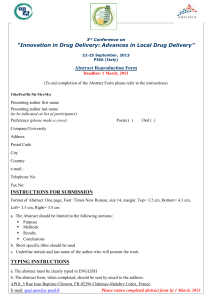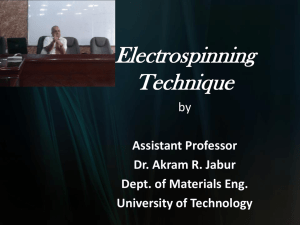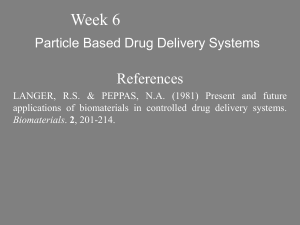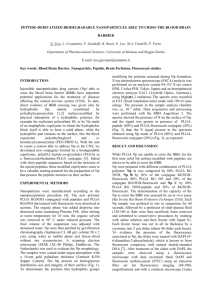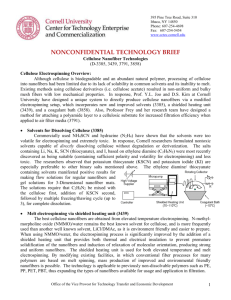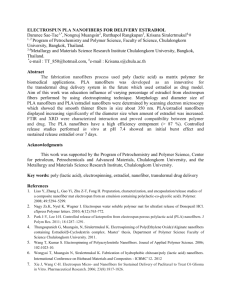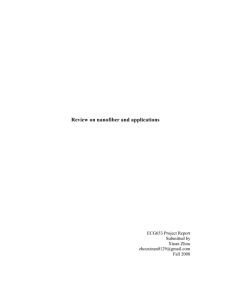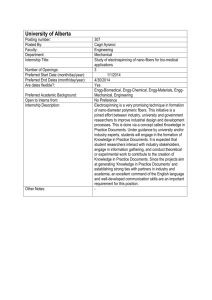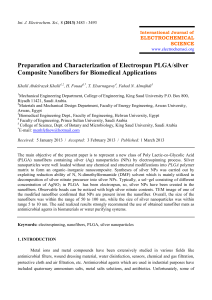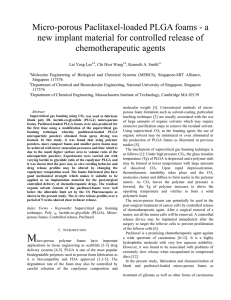Nanofibers
advertisement
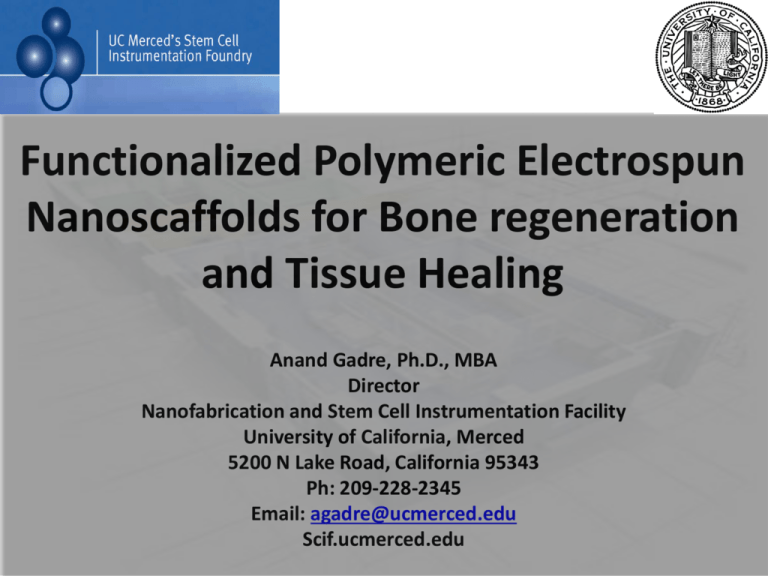
Functionalized Polymeric Electrospun Nanoscaffolds for Bone regeneration and Tissue Healing Anand Gadre, Ph.D., MBA Director Nanofabrication and Stem Cell Instrumentation Facility University of California, Merced 5200 N Lake Road, California 95343 Ph: 209-228-2345 Email: agadre@ucmerced.edu Scif.ucmerced.edu Nanofabrication and Stem Cell Instrumentation Foundry The Stem Cell Instrumentation Foundry (SCIF) provides stem cell researchers at UC Merced and throughout California access to advanced instruments, techniques and collaborators for single cell analysis. The SCIF is housed in a 4260 asf facility which includes Class 1000 and 100 clean rooms for micro/nano fabrication, facilities for human and mouse stem cell culture, quantitative cell imaging, and workstations. Objective • Generation and functionalization of Poly-Lactic-co- Glycolic Acid (PLGA) nanofiber scaffolds in the range of ~700 nm using the electrospinning technique. • Design synthetic biodegradable scaffolds comprising electrospun nanofibers that will not only be osteoconductive but also contain porosity for bone cell ingrowth enhanced with Adipose derived human Mesenchymal Stem Cells (AdhMSCs) • Sufficient amount of bioactive ingredient such as Demineralized Bone Matrix (DBM) as well as growth factors that would serve as a more conducive framework for cell adhesion, proliferation, and differentiation. Electrospinning Nanofibers: Process • Fluid is pumped through a syringe with an automatic syringe pump • The syringe needle is positively charged using a voltage supply (Several kV potential used) • The resulting electric field causes fibers to be pulled from the droplet at the end of the syringe tip and onto a grounded metal collector The Electrospinning Process Electrospinning Nanofibers Why? Fibers can be made much thinner through electrospinning than other methods. How? A solution of liquid polymer fluid is put through a capilary device to produce a droplet. Next a voltage is applied to the droplet, which reduces the surface tension, resulting in a very thin fiber being drawn out. The voltage applied is very high. Typical values range from 8 to 25 kilovolts. The diamiter of the fiber is inversly proportional to the applied voltage. The fiber is then drawn towards a collection plate by gravitational and electrostatic forces. The fibers become randomly arranged on the collection plate forming a mesh network. Electrospinning Figure 1:Experimental Electrospinning Apparatus Figure 2:Electrospinner Mechanics Controllable Parameters: •Deposition height •Too high, no fiber deposition; too low, chance of arching •Polymer Concentration •Too high, viscosity will not allow fiber formation; too low, globules of polymer will form •Voltage Applied •Too high, chance of arching, too low, not enough pull to form fibers •Flow Rate •Too high, globules form; too low, inconsistent fiber deposition •Needle Diameter: •diameter of nanofibers increase with gauge •Fiber Alignment Standardized Parameters for Nanofiber Fabrication with PLGA polymer: •Deposition height: 7cm from needle tip to receiving plate •Polymer Concentration: 10% PLGA in HFIP •Voltage Applied: 15kV •Deposition Patterning: Random Deposition (No patterning) •Flow Rate: 30 µL/Min •Needle Diameter: 20 gauge Methods Electrospinning: 15kV Power supply 5%/10% PLGA Polymer in HFIP (Hexafluoro Isopropanol) Scanning Electron Microscopy: Gold particle coating Quanta 200, FEI Mineralization Assay: Confocal Microscopy: 488, 561, 405 nm lasers Nikon Eclipse TI -Bone Differentiation was measured using Alizarin Red A dye to stain calcium mineralization Methods Cell Culture: • 5% CO2, Incubation at 37° Celsius for two weeks Biocompatibility Evaluation: • Live/Dead® cell viability assay measures the amount of live and dead cells Immunohistochemistry Staining: • DAPI, Osteocalcin and Collagen X stains were used as markers to identify differentiated ADhMSCs Confocal and Fluorescent Microscopy: • 488, 561, 405 nm lasers, Nikon Eclipse TI and EZ-C1 • Nikon TE-2000 microscope and Nikon Elements® Electrospinning of Polymeric Fibers Standard Electrospinning Process Electrospinning of Core-Shell Fibers Biocompatibility Evaluation Cell viability assay of non-PLGA sample demonstrates normal proliferation of adiposederived stem cells. PLGA film demonstrates increased differentiation of adipose-derived stem cells when grown on PLGA 5% film. PLGA 10% fiber sample demonstrates increased uniformly directed bone cell differentiation and proliferation of adipose-derived stem cells when grown on PLGA 10% nanofibers. Fluorescent Images A 5% Film • • B • 10% Fibers • • • Anti-Collagen X antibodies bind collagen excreted in the extracellular matrix of connective tissue cells Osteocalcin R stain binds osteocalcin, a noncollagen protein that is excreted in the extracellular matrix. Fluorescent images of electrospun PLGA fibers seeded with mesenchymal stem cells A&B: Samples subjected to AntiCollagen X antibodies C&D: Samples subjected to Osteo-R stain. C 5% Film D 10% Fibers Confocal Images A 5% Film Collagen X stain binds collagen excreted in the extracellular matrix of connective tissue cells B 10% Fibers Confocal images of electrospun PLGA fibers seeded with mesenchymal stem cells A&B: Samples subjected to Cal-X stain. C&D: Samples subjected to DAPI staining. C 5% Film 4,6-diamidino-2phenylindole(DAPI) stain binds osteocalcin, a noncollagen protein that is excreted in the extracellular matrix. D 10% Fibers Immunohistochemistry Staining ADhMSCs grown on 10% PLGA fiber expressed highest level of Collagen X corresponding to proliferation. However ADhMSCs stained for Osteocalcin expression showed no significant difference between in differentiation on 5% and 10% PLGA nanofibers. Nanofibers SEM image of a Random 10% PLGA nanofiber deposition. Electrospun 10% PLGA nanofiber diameter was 679nm ± 60 nm. Scale bar = 100 μm SEM image of a Aligned 10% PLGA nanofiber deposition. Electrospun 10% PLGA, nanofiber diameter was 679nm ± 60 nm. Scale bar = 20 μm Confocal image of 10% PLGA nanofibers Mineralization Assay PLGA 10% Fibers 10% PLGA-film • PLGA 10% film showed less calcium mineralization (lighter color) and therefore less bone differentiation • PLGA 10% nanofibers showed greater mineralization (darker color) and therefore greater bone differentiation • PLGA 10% Fibers with a random deposition showed similar calcium expression to that of PLGA 10% Aligned fibers PLGA 10%-Align Petri dish Discussion • Results from Live/Dead cell assay show no difference in cell vitality on PLGA nanofiber scaffolds compared to the 5% film control • Fluorescent microscopy was useful in determining general cell type while confocal microscopy provided a more defined image of cell type and nanofiber structure. • Results from confocal microscopy and immunohistochemistry staining show scaffolds containing 10% PLGA induced more ADhMSC differentiation and proliferation than 5% PLGA fibers and film. Nanofiber Applications Cosmetic skin masks •Skin cleansing •skin healing •Skin therapy Military protective clothing •minimum impedance to air •efficiency in trapping aerosol particles •anti-bio-chemical gases Application in life science •drug delivery carrier •hemostatic devices •wound dressing Tissue engineering scaffolding •porous membrane for skin •tubular shape for blood vessels and nerve regeneration •three dimensional scaffolds for bone and cartilage regeneration Polymer Nanofibers Filter media •liquid filtration •gas filtration •molecule filtration Nanosensors •thermal sensors •piezoelectric sensor •biochemical sensor •fluorescence optical chemical sensor Other electronic applications •micro/nanoelectronic devices •electronic dissipation •electromagnetic interference shielding •photovoltaic devices •LCD devices •ultra-lightweigt spacecraft materials •high efficient and functional catalysts Nanofiber Applications Drug delivery system: - Encapsulation of the drug inside the electrospun fiber - Improve therapeutic efficacy due to the high surface area and safety of drugs (Dissolution rate of a particulate drug increases with increasing surface area of both the drug and the corresponding carrier if needed.) Wound dressing: • Novel polymeric composite materials that have antimicrobial properties and variable surface properties that can reduce attachment and adhesion to the wound. • - Wound dressings having antibacterial properties would be highly desirable for wounded personnel THANK YOU Biocompatibility Figure 6: Cell viability assay of non-PLGA sample demonstrates normal proliferation of adipose-derived stem cells. Figure 7: PLGA film demonstrates increased differentiation of adiposederived stem cells when grown on PLGA 5% film. Figure 8: PLGA 10% fiber sample demonstrates increased uniformly directed bone cell differentiation and proliferation of adipose-derived stem cells when grown on PLGA 10% nanofibers. Nanofiber Application Percent Tetracycline Release PEVA Nanospun PEVA Film 60 40 20 0 0 20 40 60 80 100 120 140 Time (hrs) Percentage release of tetracycline HCl from films and nanospun mats vs. time Drug delivery Tissue engineering Wound dressing Nanofiber Application Protective Clothing Nanofiber Application Leaf with nanofibers containing pesticide Nanofibers as a physical barrier to insects Ag - particles Low - Adhesion Antibiotics Novel polymeric composite materials that have antimicrobial properties and variable surface properties that can reduce attachment and adhesion to the wound. Wound dressings having antibacterial properties would be highly desirable for wounded personnel both in the field and in a clinical setting A conceptual image of a nanofibrous wound dressing is shown. The electrospun polymer fibers would be attached to the dressing material to make direct contact with the wound. Fiber Alignment Syringe Pump High Voltage Power Supply Discussion • Variations within the parameters of the electrospinning apparatus allow for the fabrication of nanofiber depositions • Nanofibers fabricated with 10% PLGA polymer provided increased bone cell differentiation. • Increased levels of overall proliferation. Project Summary • Nanofabrication and Stem Cell Instrumentation Foundry • Objective • Experimental • Results • Conclusions • Next Steps

